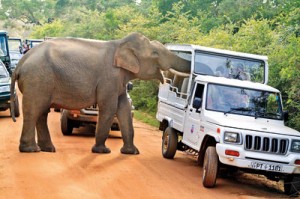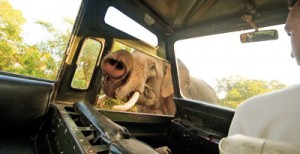News
Aussie expert calls for action plan for Yala following Gemunu’s money gobbling incident

December 2012: Gemunu looking for food
Gemunu, Yala National park’s iconic tusker has a bad habit of stealing food from visitors. What initially started off as begging for food, with time Gemunu became more aggressive– standing in the path of safari jeeps until it was given some food or sticking his trunk inside the jeeps and stealing food.
However, things went wrong this week for Gemunu when it put its trunk into a jeep in which a German couple was riding in and picked up a bag, thinking there would be a bagful of food. But instead the couple watched in horror and disbelief as Gemunu downed the bag containing cash and the travel documents.
It is reported that the tourists reported the incident to Wildlife officers so that they could obtain a letter as proof to claim insurance and get their travel documents renewed.
As Gemunu gets bolder wildlife experts worry that a fate far worse than gulping a bagful of of money and documents awaits the elephant. In addition to Gemunu there are other elephants being fed in Yala and other forest reserves of Sri Lanka. Sithulpawwa – a famous Buddhist temple located in Yala is also frequented by a tusker in search of food.
While feeding wild animals started with good intentions, people should understand it would ultimately have a negative impact on wild life – even resulting in possible fatalities, points out Prof.David Newsome of Murdoch University of Australia who studied nature-based tourism and its impact on wildlife in many different parts of the world. “Every case of feeding wild animals is different, so each needs to be carefully analysed to provide a lasting solution,” Prof. Newsome said.
Speaking to the Sunday Times, Prof. Newsome gave the example of Fraser Island in Australia where tourists closely interact with the dingo – a wild dog found in Australia. Things changed drastically when a boy was killed by dingos. Wildlife officers had to kill a number of dingos in Fraser Island following this incident.
Prof. Newsome who was in Sri Lanka recently commented on the Yala incident when he delivered the key-note address at the 21st International Forestry Symposium organised by the University of Sri Jayawardanepura annually.
“I’m not going to visit Yala as a tourist again,” prof. Newsome said. “Every wilderness has its limits in tolerating visitors and Yala being Sri Lanka’s most popular National Park needs an action plan immediately. Quality of the visitor experience is more important and just don’t forget ‘word-of-mouth’ is quicker in this era of social media – so in future tourists may avoid Yala” prof.Newsome,” said reiterating what local experts have been saying for sometime.
“Take a step back, review the situation properly, take informed decisions leading to sustainability of Yala to make sure its status as both a haven for animals as well as a tourist destination,” the expert on ecotourism advised.

Close encounter: Gemunu looking for food inside a jeep in 2013 - A thrilling, but scary view from inside Pic by Riyaz Carder

